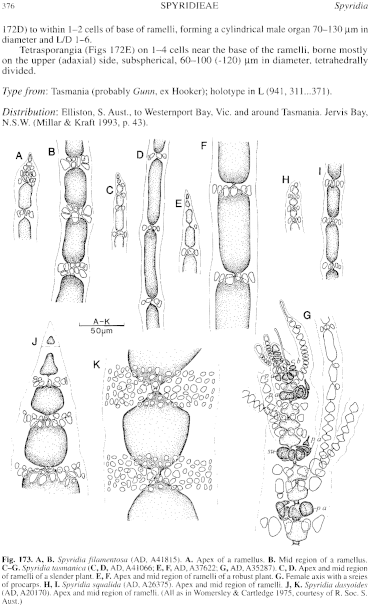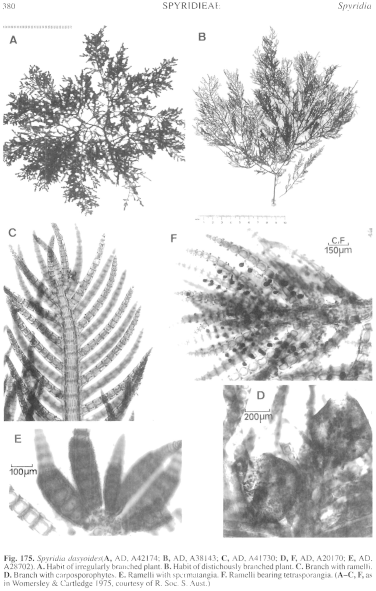|
|
|
|
|
|||||||||||
|
Electronic Flora of South Australia Species Fact Sheet
Phylum Rhodophyta – Order Ceramiales – Family Ceramiaceae – Tribe Spyridieae
Selected citations: J. Agardh 1876: 272. De Toni 1903: 1437. Harvey 1863, synop.: 42. Huisman et al. 1990: 97. Kendrick et al. 1990: 52. Lucas 1909: 52. Lucas & Perrin 1947: 364. May 1965: 369. Millar & Kraft 1993: 42. Okamura 1932: 130. Silva et al. 1996: 426. Sonder 1881: 16. Tate 1882: 18. Tisdall 1898: 505. Womersley & Cartledge 1975: 231, figs 3J, K, S.
Synonyms
S. opposita Harvey 1855b: 256; 1860: pl. 158. Adams 1972: 83. J. Agardh 1876: 270; 1897: 14. De Toni 1903: 1431; 1924: 502. Guiler 1952: 98. Lucas 1909: 52; 1929a: 25; 1929b: 53. Lucas & Perrin 1947: 363, fig. 182. May 1965: 369. Mazza 1912, No. 421. Okamura 1932: 130. Reinbold 1897: 60. Shepherd & Womersley 1970: 135. Sonder 1881: 16. Tate 1882: 18. Tisdall 1898: 505. Wilson 1892: 181. Womersley 1950: 180; 1966: 151.
S. prolifera Harvey 1863: pl. 274. J. Agardh 1876: 269; 1897: 14. De Toni 1903: 1431. Lucas 1909: 52. Lucas & Perrin 1947: 362, fig. 181. May 1965: 369. Mazza 1912, No. 422. Sonder 1881: 16.
Thallus (Fig. 175A, B) dark red to red-brown, usually 10–20 cm high, erect, much branched irregularly to subdistichously with one to several axes; axes and larger branches heavily corticated, terete to angular and becoming four-sided with thickened cortical flanges in line with the 4 ranks (Fig. 175C) of ramelli, densely branched. Axes 1–2 (–2.5) mm in diameter, often denuded but sometimes with numerous, short, proliferous branches, tapering to 0.5–0.8 mm in diameter with lesser branches 0.2–0.5 mm in diameter; laterals arising from nodal cells. Holdfast discoid, soon becoming fibrous and stoloniferous; epilithic or epiphytic. Structure. Segments largely obscured by cortication, L/D 0.5–1, with 8 periaxial cells producing 16 internodal cells and the 8 cells soon with interposed rhizoidal cells giving both nodal and internodal rings of 16 cells (Fig. 175C); cortication commencing within a few segments of apices, of elongate cells and later appearing pseudoparenchymatous, a few cells thick on lesser branches, many (especially on flanges) cells thick on axes. Ramelli (Figs 173J, K, 175C) arising from an enlarged periaxial cell, in opposite and more or less decussate pairs (Fig. 175C) on successive segments (often displaced to two rows on each side in the plane of branching), (1–) 1.5–2 (–2.5) mm and (16–) 18–22 cells long, relatively uniform in diameter but tapering fairly abruptly to a point, (70–) 100–150 µm in basal diameter, cells L/D about 1 (–1.5). Ramelli with 16–20 nodal cells, each cutting off 1–2 cells (which often divide again) on both sides (anteriorly first), producing a nodal band (2–) 3–4 (–6) cells broad (Fig. 173K). Cells uninucleate; rhodoplasts discoid to elongate.
Reproduction: Gametophytes dioecious. Female axes with alternating sterile and procarpic segments, the latter with a 4-celled carpogonial branch on the supporting cell and usually two other periaxial cells. The mature carposporophyte (Fig. 175D) is short-stalked, irregularly globular to bilobed, 400–600 µm across, with two or three discrete lobes and the pericarp is relatively firm at its periphery. Spermatangia (Fig. 175E) cover the lower (except basal) several segments of young ramelli of adventitious branchlets lying between older ramelli, forming male organs 120–200 µm in diameter.
Tetrasporangia (Fig. 175F) sessile, 1–3 per cell, mostly on the upper (adaxial) side of the ramelli, subspherical, 50–90 µm in diameter, tetrahedrally divided.
Type from Holdfast Bay, S. Aust. (Ev.Mueller); holotype in MEL, 45128.
Selected specimens: Port Denison, W. Aust., drift (Kraft, 14.xii.1971; AD, A41730). Eyre, W. Aust., drift (Woelkerling, 22.xi.1968; AD, A34248). Twin Rocks, Head of Great Australia Bight, S. Aust., 20–22 m deep (Branden, 19.i.1991; AD, A61132). Point Avoid, S. Aust., upper sublittoral pools (Ricci, 12.ii.1994; AD, A63346). Investigator Strait, S. Aust., 43 m deep (Watson, 27.i.1971; AD, A38143). Port Noarlunga, S. Aust., 5 km offshore on scallops, 24 m deep (Ottaway, 3.ii.1981; AD, A52083). West I., S. Aust., 25 m deep (Shepherd, 12.v.1973; AD, A43570). Vivonne Bay, Kangaroo I., S. Aust., drift (Womersley, 30.i.1956; AD, A20170). Seal Bay, Kangaroo I., S. Aust., drift (Womersley, 21.i.1965; AD, A28702). Cable Hut Reef, E of Penneshaw, Kangaroo I., S. Aust., 15–21 m deep (Lavers, 14.ii.1996; AD, A64837). Cape Lannes, S. Aust., drift (Cartledge, 14.v.1972; AD, A42174). Stinky Bay Point, Nora Creina, S. Aust., 1–3 m deep (Miller, 26.x.1996; AD, A66740). Lady Julia Percy I., Vic., 20 m deep (Shepherd, 4.i.1968; AD, A32456). Cape Woolamai, Vic., 20 m deep (Watson, 10.iii.1969; AD, A34493). Gabo I., Vic., 18 m deep (Shepherd, 17.ii.1973; AD, A43504).
Distribution: Port Denison, W. Aust. to Gabo I., Victoria and N.S.W. (Millar & Kraft 1993, p. 42).
Taxonomic notes: S. dasyoides usually occurs on rough-water coasts from low tide level to depths of 33 m. Deeper growing plants are usually more delicate than those growing in turbulent conditions. It is characterised by its robust, opposite and more or less decussate ramelli, with cells about as long as broad and nodal bands 3–5 cells broad, together with the largely distichous branching. Eight periaxial cells are formed in branches and soon become separated by rhizoidal cells, thus forming both nodal and internodal rings of usually 16 cells, the bands being about equal in length.
References:
ADAMS, N.M. (1972). The marine algae of the Wellington area. A list of species. Rec. Dom. Mus. (Wellington) 8(5), 43–98.
AGARDH, J.G. (1876). Species Genera et Ordines Algarum. Vol. 3, Part 1- Epicrisis systematic Floridearum, pp. i-vii, 1–724. (Weigel: Leipzig.)
AGARDH, J.G. (1897). Analecta Algologica. Cont. IV. Acta Univ. lund. 33, 1–106, Plates 1, 2.
DE TONI, G.B. (1903). Sylloge Algarum omnium hucusque Cognitarum. Vol. 4. Florideae. Sect. 3, pp. 775–1521 + 1523–1525. (Padua.)
DE TONI, G.B. (1924). Sylloge Algarum omnium hucusque Cognitarum. Vol. 6. Florideae. (Padua.)
GUILER, E.R. (1952). The marine algae of Tasmania. Checklist with localities. Pap. Proc. R. Soc. Tasmania 86, 71–106.
HARVEY, W.H. (1855b). Short characters of some new genera and species of algae discovered on the coast of the Colony of Victoria, Australia. Ann. Mag. Nat. Hist. 15 (ser. 2), 332–336.
HARVEY, W.H. (1860). Phycologia Australica. Vol. 3, Plates 121–180. (Reeve: London.)
HARVEY, W.H. (1863). Phycologia Australica. Vol. 5, Plates 241–300, synop., pp. i-lxxiii. (Reeve: London.)
HUISMAN, J.M., KENDRICK, G.A., WALKER, D.I. & COUTÉ, A. (1990). The Marine Algae of Shark Bay, Western Australia. Research in Shark Bay. Report of the France-Australe Bicentenary Expedition Committee, pp. 89–100.
KENDRICK, G.A., HUISMAN, J.M. & WALKER, D.I. (1990). Benthic macroalgae of Shark Bay, Western Australia. Bot. Mar 33, 47–54.
LUCAS, A.H.S. & PERRIN, F. (1947). The Seaweeds of South Australia. Part 2. The Red Seaweeds. (Govt Printer: Adelaide.)
LUCAS, A.H.S. (1909). Revised list of the Fucoideae and Florideae of Australia. Proc. Linn. Soc. N.S.W. 34, 9–60.
LUCAS, A.H.S. (1929a). The marine algae of Tasmania. Pap. Proc. R. Soc. Tasm. 1928, 6–27.
LUCAS, A.H.S. (1929b). A census of the marine algae of South Australia. Trans. R. Soc. S. Aust. 53, 45–53.
MAY, V. (1965). A census and key to the species of Rhodophyceae (red algae) recorded from Australia. Contr. N.S.W. natn. Herb. 3, 349–429.
MAZZA, A. (1912). Saggio di Algologia Oceanica. Nuova Notarisia 23, Nos. 415–447.
MILLAR, A.J.K. & KRAFT, G.T. (1993). Catalogue of marine and freshwater Red Algae (Rhodophyta) of New South Wales, including Lord Howe Island, South-western Pacific. Aust. Syst. Bot. 6, 1–90.
OKAMURA, K. (1932). The distribution of marine benthic algae in Pacific waters. Rec. Océanogr. Works Jap. 3, 30–150.
REINBOLD, T. (1897). Die Algen der Lacepede und Guichen Bay und deren näherer Umgebung (Süd Australien), gesammelt von Dr. A. Engelhart-Kingston. Nuova Notarisia 8, 41–62.
SHEPHERD, S.A. & WOMERSLEY, H.B.S. (1970). The sublittoral ecology of West Island, South Australia: I. Environmental Features and algal ecology. Trans. R. Soc. S. Aust. 94, 105–137, p11.
SILVA, P.C., BASSON, P.W. & MOE, R.L. (1996). Catalogue of the Benthic Marine Algae of the Indian Ocean. (University of California Press: Berkeley, Los Angeles & London.)
SONDER, O.W. (1853). Plantae Muellerianae. Algae. Linnaea 25, 657–709.
SONDER, O.W. (1881). In Mueller, F., Fragmenta Phytographiae Australiae. Supplementum ad volumen undecinum: Algae Australianae hactenus cognitae, pp. 1–42, 105–107. (Melbourne.)
TATE, R. (1882). A list of the charas, mosses, liverworts, lichens, fungs, and algals of extratropical South Australia. Trans. R. Soc. S. Aust. 4, 5–24.
TISDALL, H.T. (1898). The algae of Victoria. Rep. 7th Meet. Aust. Ass. Adv. Sci., Sydney, 1898, pp. 493–516.
WILSON, J.B. (1892). Catalogue of algae collected at or near Port Phillip Heads and Western Port. Proc. R. Soc. Vict. 4, 157–190.
WOMERSLEY, H.B.S. & CARTLEDGE, S.A. (1975). The southern Australian species of Spyridia (Ceramiaceae, Rhodophyta). Trans. R. Soc. S. Aust. 99(4), 221–234.
WOMERSLEY, H.B.S. (1950). The marine algae of Kangaroo Island. III. List of Species 1. Trans. R. Soc. S. Aust. 73, 137–197.
WOMERSLEY, H.B.S. (1966). Port Phillip survey, 1957–1963: Algae. Mem. natn. Mus., Vict. No. 27, 133–156.
The Marine Benthic Flora of Southern Australia Part IIIC complete list of references.
Publication:
Womersley, H.B.S. (24 December, 1998)
The Marine Benthic Flora of Southern Australia
Rhodophyta. Part IIIC. Ceramiales – Ceramiaceae, Dasyaceae
©State Herbarium of South Australia, Government of South Australia
Illustrations in Womersley Part IIIA, 1998: FIGS 173J, K, 175.

Figure 173 enlarge
Fig. 173. A, B. Spyridia filamentosa (AD, A41815). A. Apex of a ramellus. B. Mid region of a ramellus. C–G. Spyridia tasmanica (C, D, AD, A41066; E, F, AD, A37622; G, AD, A35287). C, D. Apex and mid region of ramelli of a slender plant. E, F. Apex and mid region of ramelli of a robust plant. G. Female axis with a sreies of procarps. H, I. Spyridia squalida (AD, A26375). Apex and mid region of ramelli. J, K. Spyridia dasyoides (AD, A20170). Apex and mid region of ramelli. (All as in Womersley & Cartledge 1975, courtesy of R. Soc. S. Aust.)

Figure 175 enlarge
Fig. 175. Spyridia dasyoides (A, AD, A42174; B, AD, A38143; C, AD, A41730; D, F, AD, A20170; E, AD, A28702). A. Habit of irregularly branched plant. B. Habit of distichously branched plant. C. Branch with ramelli. D. Branch with carposporophytes. E. Ramelli with spermatangia. F. Ramelli bearing tetrasporangia. (A–C, F, as in Womersley & Cartledge 1975, courtesy of R. Soc. S. Aust.)

|
Email Contact: State Herbarium of South Australia |

|